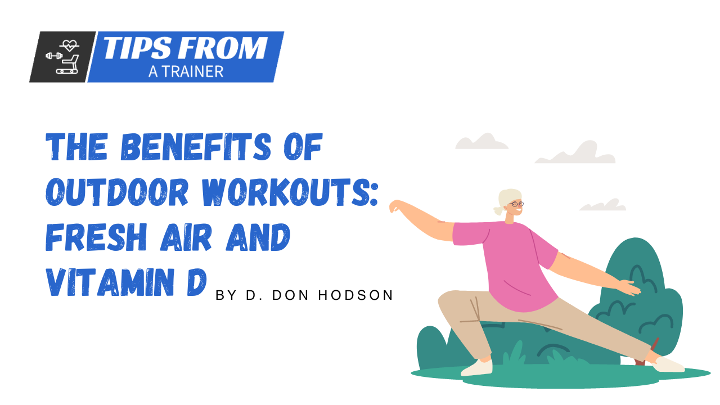Introduction
In today's fast-paced and often sedentary lifestyles, finding ways to stay fit and maintain optimal health is crucial.
While indoor gyms and fitness centers have their perks, there's an undeniable appeal to taking your workout routine outdoors. The connection with nature, the invigorating fresh air, and the opportunity to soak up vitamin D from the sun make outdoor workouts a compelling choice for fitness enthusiasts.
In this comprehensive article, we will explore the numerous benefits of outdoor workouts in great detail, with a specific focus on the positive impact of fresh air and the opportunity to harness the power of vitamin D.
Table of Contents
Introduction
The Importance of Fresh Air for Physical and Mental Well-being
Harnessing the Power of Vitamin D: The Sunshine Vitamin
Boosting Physical Performance Through Outdoor Workouts
Terrain Variation and Functional Movements
Natural Resistance Training
Mental Stimulation and Motivation
Increased Caloric Expenditure
The Psychological Benefits of Outdoor Workouts
Stress Reduction and Mental Well-being
Connection With Nature
Enhanced Mental Focus and Cognitive Function
Increased Social Interaction and Community Engagement
Safety Considerations for Outdoor Workouts
Check The Weather
Stay Hydrated
Dress Appropriately
Protect Yourself from the Sun
Be Mindful of Surroundings
Warm-Up And Cool-Down
Modify Intensity and Progress Gradually
Carry Identification and Communication
Conclusion

The Importance of Fresh Air for Physical and Mental Well-being
When it comes to the benefits of outdoor workouts, fresh air plays a pivotal role. It is not merely a matter of comfort; there are tangible benefits that contribute to our overall physical and mental well-being. When we exercise outdoors, we have the privilege of breathing in cleaner air compared to indoor environments, which are often filled with recycled air and pollutants.
One significant advantage of fresh air is its positive impact on mood and mental well-being. Numerous studies have demonstrated the therapeutic effects of spending time in natural environments. The combination of physical activity and exposure to nature releases endorphins, often referred to as "feel-good" hormones, which contribute to an improved mood and a greater sense of well-being. The tranquility and beauty of outdoor settings can reduce stress, anxiety, and depression, providing a soothing and rejuvenating experience for individuals.
Moreover, the quality of the air we breathe during outdoor workouts is markedly different from that in enclosed spaces. Indoor air can be laden with various pollutants, such as volatile organic compounds (VOCs) and allergens, which can negatively impact respiratory health. In contrast, outdoor air tends to be fresher and more oxygen-rich. When we engage in physical activities outside, we can take deeper and more expansive breaths, allowing our lungs to fully expand and enabling increased oxygen absorption. This oxygen-rich air fuels our muscles, enhancing our endurance and performance during workouts. It also aids in the efficient removal of carbon dioxide and other metabolic waste products from our bodies.
Research has consistently highlighted the benefits of outdoor workouts in natural environments. A study published in the journal Environmental Science and Technology found that exercising in green spaces, such as parks or forests, led to greater feelings of revitalization and increased energy compared to indoor exercise. Furthermore, participants reported a higher level of enjoyment and a greater likelihood of repeating the outdoor workout experience. This suggests that the combination of physical activity, fresh air, and natural surroundings has a synergistic effect on our well-being, providing a more fulfilling and rewarding fitness experience.
Harnessing the Power of Vitamin D: The Sunshine Vitamin
Vitamin D, often referred to as the "sunshine vitamin," is a vital nutrient that our bodies require for optimal health. It plays a crucial role in various bodily functions and is essential for our overall well-being. One of the primary sources of vitamin D is sunlight. When our skin is exposed to ultraviolet B (UVB) rays from the sun, a series of chemical reactions occur, resulting in the synthesis of vitamin D within our bodies. Engaging in outdoor workouts provides an excellent opportunity to tap into the power of sunlight and optimize our vitamin D levels.
Maintaining adequate vitamin D levels offers numerous benefits for our bodies. Firstly, vitamin D is crucial for calcium absorption, promoting healthy bones and teeth. It plays a vital role in regulating calcium and phosphorus levels in the body, ensuring proper mineralization and skeletal health. Insufficient vitamin D levels can lead to weakened bones, increased risk of fractures, and conditions such as osteoporosis.
In addition to its role in bone health, vitamin D supports our immune system, helping to defend against pathogens and reducing the risk of infections. It has been linked to a lower incidence of respiratory tract infections, including the common cold and influenza. Vitamin D also plays a role in regulating our cardiovascular health, as studies have shown that adequate vitamin D levels are associated with a reduced risk of heart disease and hypertension.
Furthermore, emerging research suggests a connection between vitamin D and exercise performance. Several studies have indicated that individuals with adequate vitamin D levels tend to exhibit better muscle strength and endurance. Vitamin D is involved in muscle protein synthesis, which is crucial for muscle repair and growth. It also contributes to muscle function, coordination, and balance, all of which are essential for optimal exercise performance.
By incorporating outdoor workouts into our fitness routines, we have the opportunity to naturally harness the power of sunlight and optimize our vitamin D levels. This approach to vitamin D intake is preferable to relying solely on supplements, as it allows our bodies to produce vitamin D in a more balanced and efficient manner.
Boosting Physical Performance Through Outdoor Workouts
Outdoor workouts offer a multitude of advantages when it comes to boosting physical performance. The dynamic and ever-changing outdoor environment presents a range of challenges that can significantly enhance our fitness levels, coordination, and overall athleticism.
Terrain Variation and Functional Movements
Exercising outdoors exposes us to diverse terrains, such as hills, trails, sand, or grass. These natural elements require our bodies to adapt and engage different muscle groups to maintain balance and stability. Unlike the controlled environment of a gym, outdoor workouts promote functional movements that mimic real-life activities. For instance, running on a trail with uneven surfaces engages the stabilizer muscles in the ankles, knees, and hips, improving proprioception and joint stability. Similarly, hiking on challenging terrain activates the muscles in the lower body, including the quads, hamstrings, and glutes, leading to greater strength and endurance.
Natural Resistance Training
Nature itself provides an opportunity for resistance training during outdoor workouts. Utilizing elements such as rocks, fallen logs, or even our own body weight against gravity can add resistance to exercises and intensify the workout. For example, performing push-ups on an inclined surface like a hill or using tree branches for pull-ups challenges our muscles in unique ways, promoting strength development and muscle engagement. The irregular and varied surfaces encountered during outdoor workouts also activate smaller stabilizing muscles, enhancing overall muscular balance and coordination.
Mental Stimulation and Motivation
Exercising in natural surroundings offers a remarkable element of mental stimulation that can have a positive impact on our performance. The changing scenery, the sounds of nature, and the exploration of new routes or trails create an immersive and captivating workout experience. This mental engagement can boost motivation, focus, and drive, helping us push through challenging workouts and achieve better results. Additionally, exposure to natural environments has been associated with reduced stress levels and improved mental clarity, providing an overall sense of well-being and mental rejuvenation.
Increased Caloric Expenditure
Outdoor workouts often involve more movement and engagement of multiple muscle groups compared to indoor exercises. The varied terrain and natural obstacles require our bodies to work harder, resulting in increased caloric expenditure. For example, trail running or hiking uphill requires more effort and energy expenditure than running on a treadmill, leading to a more intense cardiovascular workout. Additionally, outdoor activities like swimming, cycling, or playing sports in natural settings provide a fun and effective way to burn calories and improve overall fitness.
The Psychological Benefits of Outdoor Workouts
Beyond the physical advantages, outdoor workouts offer numerous psychological benefits that contribute to our overall well-being and mental health. The combination of physical activity, exposure to nature, and the absence of the typical urban environment creates a unique setting for improving mental well-being.
Stress Reduction and Mental Well-being
Spending time in nature has been shown to have a calming and stress-reducing effect on the mind. Outdoor workouts provide an opportunity to escape from the pressures of daily life, allowing us to immerse ourselves in a natural environment. The combination of physical activity, fresh air, and the beauty of nature promotes relaxation, reduces anxiety, and improves overall mental well-being. Research has shown that engaging in outdoor activities can lower cortisol levels (the stress hormone) and increase serotonin production, leading to improved mood and a greater sense of calmness.
Connection with Nature
Humans have an innate connection with the natural world, and incorporating outdoor workouts allows us to tap into that connection. Exercising in nature provides an opportunity to appreciate the beauty of our surroundings, reconnect with the earth, and develop a sense of gratitude and mindfulness. This connection with nature has been shown to enhance feelings of happiness, contentment, and overall life satisfaction. Additionally, being in natural settings stimulates our senses and engages our curiosity, fostering a sense of awe and wonder that can further boost our psychological well-being.
Enhanced Mental Focus and Cognitive Function
The outdoor environment offers a unique sensory experience that can enhance our mental focus and cognitive function. Studies have found that spending time in nature improves attention, memory, and creativity. The combination of physical activity and exposure to natural elements activates different regions of the brain, promoting cognitive flexibility and problem-solving skills. Whether it's a brisk walk in the park or practicing yoga in a serene outdoor setting, these activities can help clear our minds, improve concentration, and enhance mental clarity.
Increased Social Interaction and Community Engagement
Outdoor workouts often create opportunities for social interaction and community engagement. Parks, trails, and outdoor fitness classes provide a platform for individuals to come together, share experiences, and build connections with like-minded individuals. Engaging in group activities or joining outdoor sports leagues not only promotes physical fitness but also fosters a sense of belonging and camaraderie. The social aspect of outdoor workouts can provide motivation, accountability, and a support network, contributing to long-term adherence and enjoyment of physical activity.
By embracing outdoor workouts and incorporating them into our fitness routines, we can experience a multitude of physical and psychological benefits. The natural environment offers a unique and refreshing backdrop for physical activity, providing challenges, stimulation, and an opportunity to connect with nature. Moreover, the psychological advantages, such as reduced stress, improved mental well-being, and increased social interaction, further enhance the overall fitness experience.
Safety Considerations for Outdoor Workouts
While outdoor workouts offer numerous benefits, it's important to prioritize safety to ensure a positive and injury-free experience. Consider the following safety guidelines when engaging in outdoor exercise:
Check the Weather
Before heading out for an outdoor workout, check the weather forecast to ensure safe conditions. Extreme heat, thunderstorms, or icy conditions can pose risks to your well-being. Adjust your workout plans accordingly or consider alternative indoor activities if the weather is unfavorable.
Stay Hydrated
Outdoor workouts often result in increased perspiration and fluid loss. Stay hydrated by drinking an adequate amount of water before, during, and after your exercise session. Carry a water bottle with you and take regular sips to replenish fluids.
Dress Appropriately
Dress in comfortable, moisture-wicking clothing that suits the weather conditions. In hot weather, opt for light-colored, breathable fabrics that allow for air circulation. In colder temperatures, layer your clothing to maintain warmth and remove layers as needed during exercise. Don't forget to wear appropriate footwear that provides support and traction for the outdoor terrain.
Protect Yourself from the Sun
When exercising outdoors, protect your skin from harmful UV rays. Apply sunscreen with a high SPF to exposed areas of your body, wear a hat or visor to shield your face, and consider wearing sunglasses to protect your eyes. Seek shade whenever possible, especially during peak sun hours.
Be Mindful of Surroundings
Pay attention to your surroundings during outdoor workouts. Watch out for uneven surfaces, obstacles, or potential hazards in your path. Stay alert and aware of other pedestrians, cyclists, or vehicles sharing the same space. If using headphones, keep the volume at a level that allows you to hear environmental sounds and stay safe.
Warm-up and Cool-down
Prior to starting your outdoor workout, perform a dynamic warm-up routine to prepare your muscles and joints for the activity. After your workout, cool down with static stretches to promote flexibility and aid in recovery. Taking the time for proper warm-up and cool-down can help reduce the risk of injuries.
Modify Intensity and Progress Gradually
Listen to your body and adjust the intensity of your workout based on your fitness level and comfort. Start with shorter durations and lower intensities, gradually increasing as your fitness improves. Avoid pushing yourself too hard, too quickly, as this can lead to overexertion and injuries.
Carry Identification and Communication
It's important to have identification on you, especially when exercising alone. Carry a form of identification, such as a driver's license or ID bracelet, that includes your emergency contact information. Additionally, consider taking a fully charged cell phone with you in case of emergencies or the need to contact someone for assistance.
Remember, safety should always be a top priority during outdoor workouts. By following these guidelines, you can minimize risks and maximize the enjoyment and benefits of exercising in nature.
Conclusion
Outdoor workouts provide a refreshing and invigorating way to improve physical fitness, mental well-being, and overall health. The combination of natural elements, fresh air, and the beauty of nature creates a unique environment that enhances the fitness experience. From cardiovascular exercises to strength training and mind-body practices, outdoor workouts offer a wide range of options to suit individual preferences and goals.
By embracing outdoor workouts, you can enjoy the advantages of increased vitamin D exposure, improved mood, enhanced cognitive function, and a stronger connection with nature. Whether it's a jog in the park, a hike in the mountains, or a yoga session on the beach, the benefits of outdoor exercise are undeniable.
Remember to plan your outdoor workouts, be mindful of safety considerations, and adapt your routines to the changing seasons and weather conditions. Stay hydrated, protect yourself from the sun, and listen to your body. Find joy in the natural environment, explore new trails, and appreciate the beauty that surrounds you.
So, lace up your sneakers, grab your water bottle, and step outside into the world of outdoor fitness. Let the sunshine, fresh air, and open spaces invigorate your body, mind, and soul. Start reaping the countless rewards of outdoor workouts today.

Don Hodson, Certified Personal Trainer
I'm Don, an ACE-certified personal trainer and the founder of Tips From A Trainer. With my passion for fitness and years of experience, I've helped countless individuals transform their physiques!
Having personally overcome weight challenges throughout my life, I understand the struggle. Through consistency, exercise, and a balanced diet, I have managed to stay in shape and I want to share my message with the world!
The fitness industry is fraught with misconceptions and deceptive practices, which is why I am committed to providing you with the truth.
- My Site: www.Don-Hodson.com
- My Company: www.ConnectedAgeMarketing.com

The Benefits of Outdoor Workouts